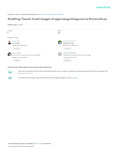Modelling Climate-based changes of sugarcane growing areas in Western Kenya

View/
Date
2016Author
Kigen, Charles
Makindi, Stanley Maingi
Masibayi, Edward N
Agevi, Humphrey
Odira, Zedekiah
Muyekho, Francis
Metadata
Show full item recordAbstract
Sugar cane (Saccharum spp. hybrids) is an important cash crop for Kenya’s sugar industry contributing
significantly to the country’s economy through farming and employment. Its production in Kenya is both
irrigation and weather dependent. In Western Kenya, it is a major economic activity heavily dependent by
more than 50% of the population. To plan for sustainable development of the counties in western Kenya,
it is important to understand how the anticipated climate change will influence this cash crop. This paper
modeled the potential sugarcane growing areas of current and the year 2050 climatic periods. The
sugarcane location data were extracted using fishnet from published materials while climate data was
obtained from world climate database website. Data analysis and modeling was done using Maxent and
DIVA-GIS softwares. The model generated an excellent Area Under Curve of 0.996 and more than 0.6
suitability level areas increased by 167.21% in 2050 climatic period. The main variables contributing
more than 5% of change in suitability areas are Precipitation of Driest Period (42%), Precipitation of
Coldest Quarter (28.8%), Isothermality (13.3%) and Precipitation of Wettest Quarter (8.1%). The
generated information will guide the policy makers and stakeholders in making informed decisions with
regard to the efforts of promotion of sugarcane production in western Kenya Counties
